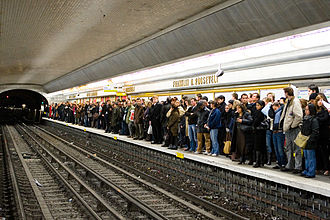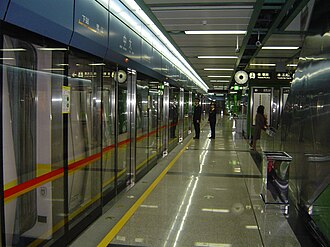Rapid transit






Rapid transit, also known as metro, subway, or underground, is a type of high-capacity public transport generally found in urban areas. Unlike buses or trams, rapid transit systems are electric railways that operate on an exclusive right-of-way, which cannot be accessed by pedestrians or other vehicles of any sort, and which is often grade separated in tunnels or on elevated railways.
Overview[edit]
Rapid transit systems are used in cities, to transport large numbers of people quickly over short distances. They are especially useful in cities with high population densities. Rapid transit is known for its high speed, safety, and efficiency. Systems are typically integrated with other forms of public transport, offering seamless connections to buses, trams, and commuter rail services.
History[edit]
The concept of rapid transit has evolved over the years, with the first systems being developed in the late 19th century. The London Underground is widely regarded as the first rapid transit system, opening in 1863. Following London, cities such as New York City with its subway, and Paris with its Métro, began to develop their own systems in the early 20th century.
Technology[edit]
Rapid transit systems utilize a variety of technologies to operate. Electrically powered trains run on fixed rails, offering smoother and faster rides than road-based transport. Modern systems often use automated trains and advanced signaling technology to increase efficiency and safety.
Infrastructure[edit]
The infrastructure of a rapid transit system includes the tracks, stations, and power supply. Stations are typically located at regular intervals throughout the system, providing easy access for passengers. Many systems are known for their distinctive architecture and design, turning stations into cultural landmarks.
Operations[edit]
The operation of a rapid transit system involves scheduling, train dispatching, and passenger information systems. High-frequency service is a hallmark of rapid transit, with trains arriving every few minutes during peak times. Fare collection methods vary, with many systems using electronic ticketing systems to streamline operations.
Impact[edit]
Rapid transit systems have a significant impact on urban development and mobility. They reduce congestion on roads, contribute to lower air pollution levels, and promote more compact, walkable urban areas. Additionally, they provide a reliable and efficient mode of transport for millions of people daily.
Challenges[edit]
Despite their benefits, rapid transit systems face several challenges, including high construction and operational costs, the need for continuous maintenance and upgrades, and issues related to overcrowding and accessibility.
Future Developments[edit]
The future of rapid transit includes the integration of new technologies such as driverless trains, and the expansion of networks to serve growing urban populations. There is also a focus on sustainability, with systems moving towards the use of renewable energy sources and more energy-efficient vehicles.
Ad. Transform your life with W8MD's Budget GLP-1 injections from $75


W8MD offers a medical weight loss program to lose weight in Philadelphia. Our physician-supervised medical weight loss provides:
- Weight loss injections in NYC (generic and brand names):
- Zepbound / Mounjaro, Wegovy / Ozempic, Saxenda
- Most insurances accepted or discounted self-pay rates. We will obtain insurance prior authorizations if needed.
- Generic GLP1 weight loss injections from $75 for the starting dose.
- Also offer prescription weight loss medications including Phentermine, Qsymia, Diethylpropion, Contrave etc.
NYC weight loss doctor appointmentsNYC weight loss doctor appointments
Start your NYC weight loss journey today at our NYC medical weight loss and Philadelphia medical weight loss clinics.
- Call 718-946-5500 to lose weight in NYC or for medical weight loss in Philadelphia 215-676-2334.
- Tags:NYC medical weight loss, Philadelphia lose weight Zepbound NYC, Budget GLP1 weight loss injections, Wegovy Philadelphia, Wegovy NYC, Philadelphia medical weight loss, Brookly weight loss and Wegovy NYC
|
WikiMD's Wellness Encyclopedia |
| Let Food Be Thy Medicine Medicine Thy Food - Hippocrates |
Medical Disclaimer: WikiMD is not a substitute for professional medical advice. The information on WikiMD is provided as an information resource only, may be incorrect, outdated or misleading, and is not to be used or relied on for any diagnostic or treatment purposes. Please consult your health care provider before making any healthcare decisions or for guidance about a specific medical condition. WikiMD expressly disclaims responsibility, and shall have no liability, for any damages, loss, injury, or liability whatsoever suffered as a result of your reliance on the information contained in this site. By visiting this site you agree to the foregoing terms and conditions, which may from time to time be changed or supplemented by WikiMD. If you do not agree to the foregoing terms and conditions, you should not enter or use this site. See full disclaimer.
Credits:Most images are courtesy of Wikimedia commons, and templates, categories Wikipedia, licensed under CC BY SA or similar.
Translate this page: - East Asian
中文,
日本,
한국어,
South Asian
हिन्दी,
தமிழ்,
తెలుగు,
Urdu,
ಕನ್ನಡ,
Southeast Asian
Indonesian,
Vietnamese,
Thai,
မြန်မာဘာသာ,
বাংলা
European
español,
Deutsch,
français,
Greek,
português do Brasil,
polski,
română,
русский,
Nederlands,
norsk,
svenska,
suomi,
Italian
Middle Eastern & African
عربى,
Turkish,
Persian,
Hebrew,
Afrikaans,
isiZulu,
Kiswahili,
Other
Bulgarian,
Hungarian,
Czech,
Swedish,
മലയാളം,
मराठी,
ਪੰਜਾਬੀ,
ગુજરાતી,
Portuguese,
Ukrainian
